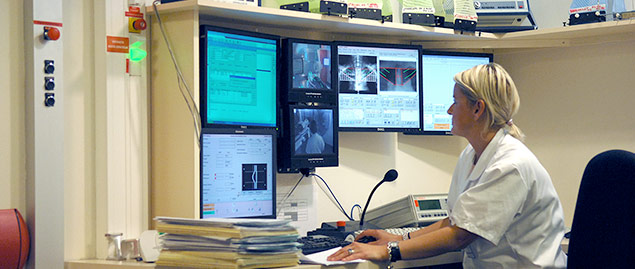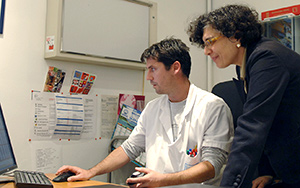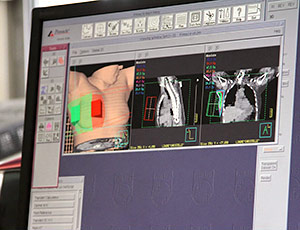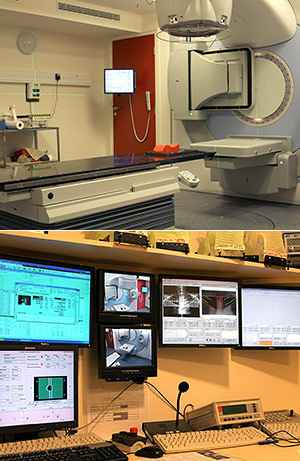Radiotherapy
Radiotherapy consists in the use of ionising radiation (X-rays) to treat tumours or prevent their recurrence.
Radiotherapy is a very efficient cancer treatment: over half the patients with tumours have this treatment at one time or another. In many cases, this treatment alone is sufficient.

Radiotherapy technician
Radiotherapy methods

The radiotherapy supervisor and Dr Sylvie Delanian
The dose, number of sessions and duration of the treatment vary according to the organ being treated, the possible combination with another treatment (chemotherapy for example) and will be determined by your radiotherapist.
In general, rays are administered in several sessions (one 10-minute session per day, five days a week from Monday to Friday over a period of two to eight weeks according to the situation) by modern and extremely complex treatment machines called linear particle accelerators.
The patient lies down on a table, which looks like a scanner table, and the machine turns around the patient to administer the X-rays to targeted areas.
Before starting the radiotherapy sessions, there are several preliminary stages:
- Consultation with the Oncologist-Radiotherapist, a doctor specialised in radiotherapy who will programme the treatment, decide on the number of sessions and the zone to be treated, and monitor you throughout the treatment.
- Localisation scanner: this is a key stage in the treatment as the scanner enables the zone needing treatment to be pinpointed. Once this scan has been carried out, the patient can go home and the radiotherapist in charge of the patient then precisely determines the tumour and post-operative area to be treated (this is referred to as conformal radiotherapy or 3D radiotherapy).
- Verification stage: once the target area has been precisely located by the doctor, the radio-physicians (medical consultants specialised in ionising radiation) will, with the doctor, draw up a treatment plan. This will be verified with the machine, especially with regards to the patient’s position on the treatment table. The area to be treated is marked with a felt pen and these marks will be kept throughout the duration of the treatment.
Once the verifications have been carried out, the radiotherapy sessions can begin at the rate of one session per day lasting about ten minutes, every day of the week except weekends and national holidays.
You will see your Radiotherapist in consultation every week to ensure that there are no or few side effects caused by the treatment.
Our radiophysics unit

Radiophysics unit
Our radiophysics unit has 5 medical physicists and 3 dosimetrists.
It is here that your treatment plan will be drawn up; in other words, the dosimetric analysis of your file will be carried out jointly by the radiotherapist and the medical physicist, assisted by the dosimetrists.
Where will the treatment be carried out?
The “Centre de Cancérologie de la Porte de Saint-Cloud” has three linear accelerators: Versa HD, Oncor and Synergy (equipped with VMAT technology). It is also equipped with a specific simulation scanner (“dedicated” scanner) coupled with a computerized dosimetry system.

Synergy particle accelerator and its monitoring screens
This technical platform enables the highest performance irradiation techniques to be carried out, and in particular conformal radiotherapy.
Our Radiotherapy Centre is one of the first in the Île-de-France area to be equipped with VMAT radiotherapy (Volumetric Modulated Arc Therapy) which it uses to treat certain cancers. This new radiotherapy method has the advantage of precisely targeting the tumour while minimising exposure of nearby healthy tissue, thus limiting any risks of side effects and complications.
Every year, 2,400 patients are treated at the Center, which corresponds to about 47,000 sessions.
Location in the establishment:
• Versa HD 1, Versa HD 2 and ZAP-X : Basement - 30 rue de Paris
• Synergy: Basement - 37 avenue Victor Hugo
What are the adverse side effects?
In most cases, reactions appear mid-treatment and decline towards the end of it. These side effects depend on the quantity of radiation administered and the area of the body being treated. Even so, patients being administered the same doses of radiation to the same area of the body may experience different side effects.
Your oncologist-radiotherapist will tell you about specific side effects that you may experience during the course of your radiotherapy.
